hatred
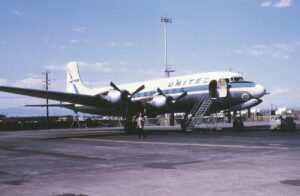 United Air Lines Flight 629, registration N37559, was a Douglas DC-6B aircraft also known as “Mainliner Denver.” The regular route for the flight was from New York City to Portland, Oregon, and then on to Seattle, Washington. This flight made one stop in Chicago and one in Denver. On November 1, 1955, United Airlines Flight 629 left New York City’s La Guardia Airport. It made a scheduled stop in Chicago before continuing to Denver’s Stapleton Airfield and landed at 6:11pm, eleven minutes late. Other than being eleven minutes late, the flight had been completely routine. The plane was refueled with 3,400 US gallons of fuel and had a crew replacement in Denver. Captain Lee Hall, aged 41, a World War II veteran, assumed command of the flight for the segments to Portland and Seattle.
United Air Lines Flight 629, registration N37559, was a Douglas DC-6B aircraft also known as “Mainliner Denver.” The regular route for the flight was from New York City to Portland, Oregon, and then on to Seattle, Washington. This flight made one stop in Chicago and one in Denver. On November 1, 1955, United Airlines Flight 629 left New York City’s La Guardia Airport. It made a scheduled stop in Chicago before continuing to Denver’s Stapleton Airfield and landed at 6:11pm, eleven minutes late. Other than being eleven minutes late, the flight had been completely routine. The plane was refueled with 3,400 US gallons of fuel and had a crew replacement in Denver. Captain Lee Hall, aged 41, a World War II veteran, assumed command of the flight for the segments to Portland and Seattle.
The flight departed Denver at 6:52pm. The flight’s last transmission came at 6:56pm, stating it was passing the Denver omni. Then, just seven minutes later, the air traffic controllers at Stapleton saw two bright lights suddenly appear in the sky north-northwest of the airport. Then, 30 to 45 seconds later, the lights fell to the ground at roughly the same speed…followed by a very bright flash originating at or near the ground. The flash was so intense that it lit up the base of the clouds 10,000 feet above the ground. The whole thing was quite strange, because there were no distress calls from aircraft in the area. They immediately contacted all aircraft flying in the area. The received responses from all the flights, except for Flight 629. The crash of Flight 629 killed all 39 passengers and five crew members.
There was nothing wrong with the plane. The pilots were not ill, nor were they insane. So, what could have brought down the plane? The initial investigation left the authorities stumped. The tail section had apparently been cleanly severed from the plane, almost as if it were cut off by a knife. The FBI consulted the Civil 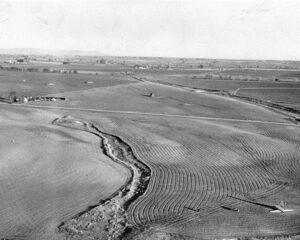 Aeronautics Board (CAB) regarding the tail section. The eyewitnesses all said the same thing. They saw a fiery explosion in the air with flares streaming down and a second explosion on impact. That would also explain the two lights falling to the ground at about the same speed, but separately. It became very apparent that there had been an explosion mid-air, that actually caused the crash, but what caused the explosion.
Aeronautics Board (CAB) regarding the tail section. The eyewitnesses all said the same thing. They saw a fiery explosion in the air with flares streaming down and a second explosion on impact. That would also explain the two lights falling to the ground at about the same speed, but separately. It became very apparent that there had been an explosion mid-air, that actually caused the crash, but what caused the explosion.
The investigation focused on the luggage and a possible bomb. They looked at passengers with insurance. The focus moved to Denver locals, looking for personal enemies. One insured was local resident Daisie Eldora King, a 53-year-old Denver businesswoman who was traveling to Alaska to visit her daughter. They located her handbag and found a number of newspaper clippings containing information about King’s son, John Gilbert Graham, who had been arrested on a forgery charge in Denver in 1951. Graham was always bitter over his childhood. His mother had placed him in an orphanage as a child. Strangely, he alone was the beneficiary of both her life insurance policies and her will. Agents also discovered that one of Mrs King’s restaurants, the Crown-A Drive-In in Denver, had been badly damaged in an explosion. The suspicions were growing. Graham had insured the restaurant and then collected on the property insurance following the blast.
Agents searched Graham’s house and automobile. In the garage they found wire and other bomb making parts that were identical to those found in the wreckage. They also found an additional $37,500 ($379,300 today) in life insurance policies. The problem…Mrs King had not signed either these policies or those purchased at the airport, rendering them worthless. Graham denied putting a bomb in his mother’s luggage, saying she had packed it herself. His wife, Gloria contradicted his story, saying that Graham had wrapped a “present” for his 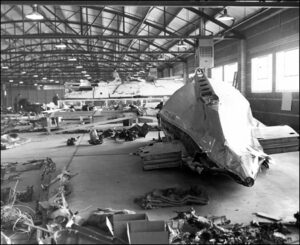 mother on the morning of Mrs King’s flight. Finally faced with mounting evidence against him, Graham admitted to having placed the bomb in his mother’s suitcase, telling the police on November 13, 1955, “I then wrapped about three or four feet of binding cord around the sack of dynamite to hold the dynamite sticks in place around the caps. The purpose of the two caps was in case one of the caps failed to function and ignite the dynamite … I placed the suitcase in the trunk of my car with another smaller suitcase…which my mother had packed to take with her on the trip.” The hatred and bitterness of one man, took the lives of 44 people, and destroyed the lives of their loved ones.
mother on the morning of Mrs King’s flight. Finally faced with mounting evidence against him, Graham admitted to having placed the bomb in his mother’s suitcase, telling the police on November 13, 1955, “I then wrapped about three or four feet of binding cord around the sack of dynamite to hold the dynamite sticks in place around the caps. The purpose of the two caps was in case one of the caps failed to function and ignite the dynamite … I placed the suitcase in the trunk of my car with another smaller suitcase…which my mother had packed to take with her on the trip.” The hatred and bitterness of one man, took the lives of 44 people, and destroyed the lives of their loved ones.
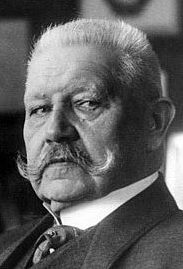
 On January 30, 1933, President Hindenburg appointed Adolf Hitler chancellor of Germany. It wasn’t because of any election, but rather by a constitutionally questionable deal dreamed up by a small group of conservative German politicians who had given up on parliamentary rule. Little did they know that they were party to appointing one of the worst dictators in history. Their attempt to return Germany to conservative authoritarian rule, backfired miserably when, within two years, Hitler and the Nazis outmaneuvered Germany’s conservative politicians to consolidate a radical Nazi dictatorship that was completely subordinate to Hitler’s personal will. I wonder if President Hindenburg wished he had never met Hitler, much less appointed him to be chancellor.
On January 30, 1933, President Hindenburg appointed Adolf Hitler chancellor of Germany. It wasn’t because of any election, but rather by a constitutionally questionable deal dreamed up by a small group of conservative German politicians who had given up on parliamentary rule. Little did they know that they were party to appointing one of the worst dictators in history. Their attempt to return Germany to conservative authoritarian rule, backfired miserably when, within two years, Hitler and the Nazis outmaneuvered Germany’s conservative politicians to consolidate a radical Nazi dictatorship that was completely subordinate to Hitler’s personal will. I wonder if President Hindenburg wished he had never met Hitler, much less appointed him to be chancellor.
Within days of taking power, the Nazis called for Germany to boycott all Jewish businesses. This unexpected anti-Jewish propaganda was the first of many. Hitler hated the Jewish people. He had no reason for his hatred. The Jewish people had done nothing to warrant Hitler’s hatred and rage. One theory is that Hitler had decided that the Jewish people were an inferior race. That is not such a new thought. It had happened before, to the African slaves in history, who had often been referred to as mud people. The Jews, as with the slaves, were treated horribly.
Another reason Hitler hated the Jewish people, was because following Germany’s loss of World War I, Hitler blamed the Jews and the communists living in Germany. He felt that they were part of a huge conspiracy against the German military. He believed that had it not been for their interference, Britain and the allies would have lost the war. Another possible reason for Hitler’s hatred of the Jews was probably jealousy. After World War I, he saw that a lot of Germans were without jobs and struggling. Instead of looking at the war as the root cause of the economic problem, he blamed the Jews for the sorry state of affairs. Because Adolf Hitler was truly insane, I’m sure that his reason to hate the Jewish people made sense to him, but the reality is that his insane mind was the only place that it made sense.
I’m not sure how he managed to get so many people to agree with is ideas, but somehow he did, and when he decided that all Jewish shops were to be boycotted, and stationed his SA Storm Troopers near the shops to 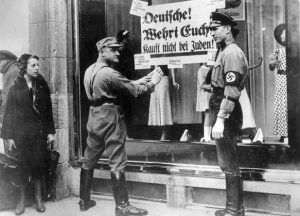
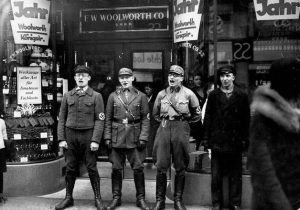
ensure that his plans were carried out, they did as they were told. It wasn’t long after the boycotting of the shops that Hitler took things to the next level, and began hauling the Jewish people to the death camps. As long as he was alive, there was no end to his hatred, and that is definitely not what President Hindenburg or the conservative German politicians had in mind, and I’m sure they wished they had never done it.
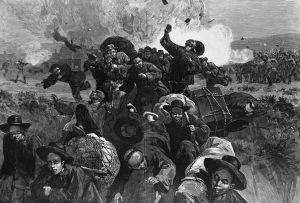 In 1885, coal miners in Rock Springs, Wyoming Territory were trying to unionize, and were trying to strike for better working conditions, but the Union Pacific Railroad company had been besting them in their efforts for a long time. In those days, the companies often had the advantage over the workers. Working conditions suffered as a result of this disadvantage. Unions and companies were constantly at odds, for obvious reasons. I suppose that in any business, there are good and bad people. Sometimes, when people come into power in an organization, corruption follows. The companies of that time didn’t want to do what was necessary to make working in the mines safe, and as most people know, underground mining can be a very dangerous occupation. The chance of cave ins or explosions exists in even the safest mines, as well as having poisonous gasses leaking into the limited air supply, bringing death to the miners.
In 1885, coal miners in Rock Springs, Wyoming Territory were trying to unionize, and were trying to strike for better working conditions, but the Union Pacific Railroad company had been besting them in their efforts for a long time. In those days, the companies often had the advantage over the workers. Working conditions suffered as a result of this disadvantage. Unions and companies were constantly at odds, for obvious reasons. I suppose that in any business, there are good and bad people. Sometimes, when people come into power in an organization, corruption follows. The companies of that time didn’t want to do what was necessary to make working in the mines safe, and as most people know, underground mining can be a very dangerous occupation. The chance of cave ins or explosions exists in even the safest mines, as well as having poisonous gasses leaking into the limited air supply, bringing death to the miners.
The situation took a deadly turn on September 2, 1885, when 150 white miners brutally attacked their Chinese coworkers, killing 28 and wounding 11 others, while driving several others out of town. The Chinese weren’t really the problem, except that they were hard workers, and so the company had initially decided to bring them in as strikebreakers. The Chinese workers showed very little interest in the miners’ union, and I’m sure this 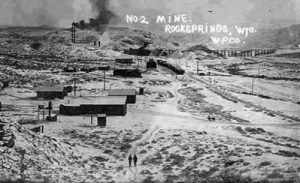 made the rest of the miners very angry. The miners became outraged by a company decision to allow the Chinese miners to work in the richest coal mines, and before long, the situation turned into a mob of white miners deciding to strike back by attacking the small area of Rock Springs known as Chinatown.
made the rest of the miners very angry. The miners became outraged by a company decision to allow the Chinese miners to work in the richest coal mines, and before long, the situation turned into a mob of white miners deciding to strike back by attacking the small area of Rock Springs known as Chinatown.
When the Chinese saw the white miners coming, most of them abandoned their homes and business, running for the hills. Those who failed to get out in time were brutally beaten, and 28 of them, beaten to death. One week later, on September 9, United States troops escorted the surviving Chinese back into the town where many of them returned to work. I guess they were either very loyal, desperate for the money, or had no other real choices, because I can’t imagine going back to work in that situation. Eventually the Union Pacific fired 45 of the white miners for their roles in the massacre, but no effective legal action was ever taken against any of the participants…no repercussion for the brutal murder of 28 Chinese men.
I wound never agree with murder, but it was also wrong to use the Chinese in this way. By bringing them in as strikebreakers, the Union Pacific Railroad effectively caused the anti-Chinese sentiment that was shared by 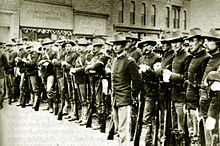 many, and began to come to the West in the mid-nineteenth century, fleeing famine and political upheaval in their own country. The Chinese were many Americans at that time. The Chinese had been victims of prejudice and violence ever since they first widely blamed for all sorts of social ills. They were also singled-out for attack by some national politicians who popularized strident slogans like “The Chinese Must Go” and helped pass an 1882 law that closed the United States to any further Chinese immigration. The Rock Springs massacre was just another symptom in this climate of racial hatred, violent attacks against the Chinese in the West became all too common. But, the Rock Springs massacre was the worst, both for its size and savage brutality.
many, and began to come to the West in the mid-nineteenth century, fleeing famine and political upheaval in their own country. The Chinese were many Americans at that time. The Chinese had been victims of prejudice and violence ever since they first widely blamed for all sorts of social ills. They were also singled-out for attack by some national politicians who popularized strident slogans like “The Chinese Must Go” and helped pass an 1882 law that closed the United States to any further Chinese immigration. The Rock Springs massacre was just another symptom in this climate of racial hatred, violent attacks against the Chinese in the West became all too common. But, the Rock Springs massacre was the worst, both for its size and savage brutality.
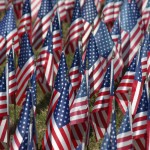 Tonight we received the news that Usama Bin Laden is dead. As I look back over the last decade, I am amazed at how much has changed. We are a different country than we were before this evil man came on the scene. Bin Laden was a man filled with hate. It was a hatred that was aimed at people of many nations and faiths. Basically this man was insane with his hatred.
Tonight we received the news that Usama Bin Laden is dead. As I look back over the last decade, I am amazed at how much has changed. We are a different country than we were before this evil man came on the scene. Bin Laden was a man filled with hate. It was a hatred that was aimed at people of many nations and faiths. Basically this man was insane with his hatred.
With the attacks of September 11, 2001, came a global distrust of others. We were leery of people who looked similar to the 9-11 attackers. We were nervous about anything odd concerning our aircraft. We became untrusting of people of different beliefs and cultures. It had to be, because we had to protect ourselves.
It is a sad thing that people can become so consumed with hate…so possessed!! Usama Bin Laden had become a cancer in the world. And like all cancers the only solution to the problem is to kill it. He would never have stopped. His hatred was so huge that he spent his fortune to recruit people to carry out his evil plans. The world can breathe a collective sigh of relief at his death.
What is unfortunate is that there are others who will continue his hatred and terrorism. Our world has many cells of people who, like Bin Laden, hate Americans and all our allies. We have to continue to be strong in our resolve to rid our world of terrorists. We may never get rid of them, but with each one that is removed, we move the tiniest bit closer to a safer world.

